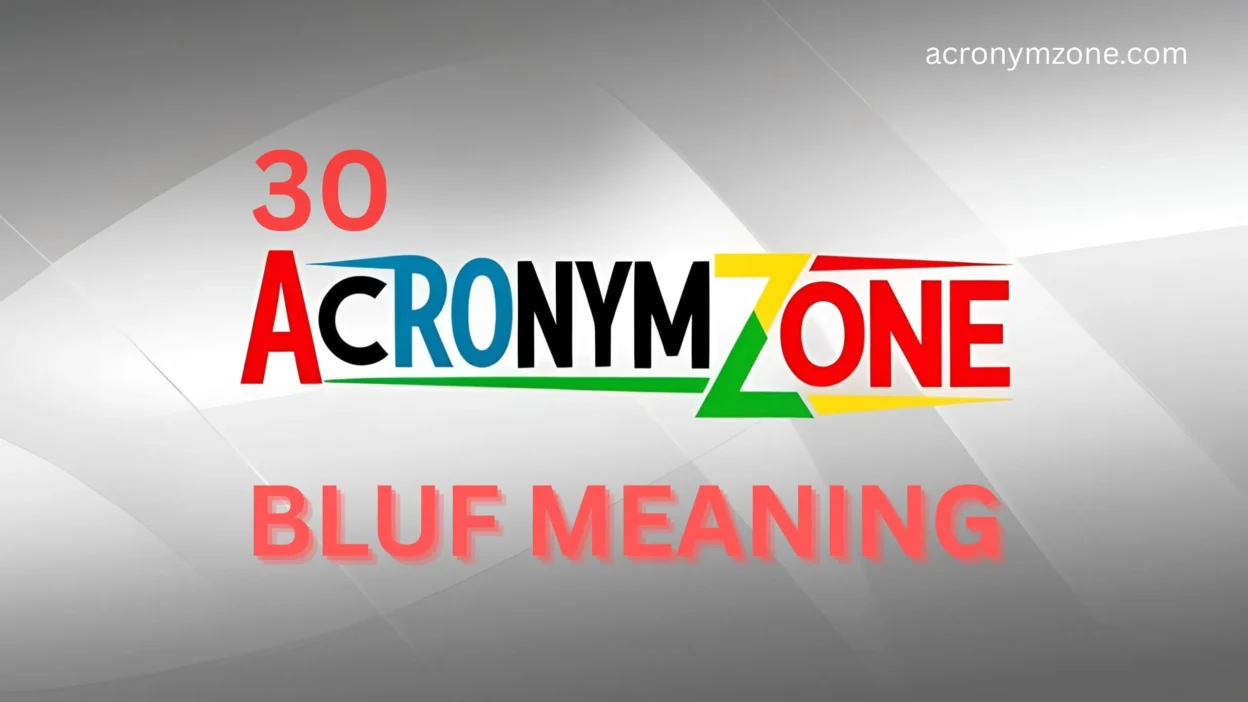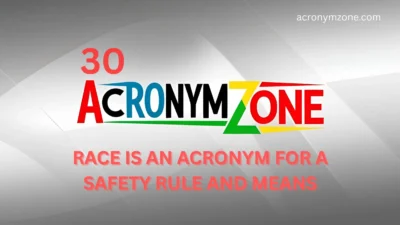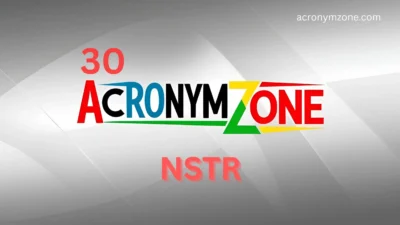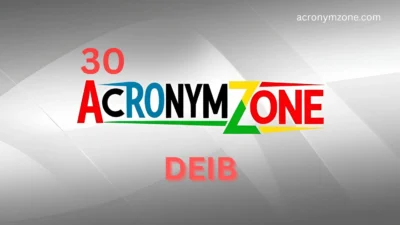Ever received a long email, only to scroll to the bottom to find the one line that actually mattered? That’s where BLUF comes in.
BLUF stands for “Bottom Line Up Front.” It’s a powerful communication strategy, especially in fast-paced environments like the military, corporate meetings, or emergency response. The idea is simple: lead with the most important information so the reader or listener doesn’t have to dig through details to understand the point.
This blog explores the meaning and nuance of the BLUF acronym, and then introduces 30 alternative acronyms or phrases that capture the essence of BLUF—clear, concise, results-driven communication. We’ll explain when each is appropriate, with examples, so you can pick the best one based on tone, setting, and cultural or emotional context.
💡 What is the BLUF Acronym?
Bottom Line Up Front (BLUF) is more than just a writing technique—it’s a mindset.
Core Traits of BLUF-style Communication:
- Direct – No fluff or buildup.
- Goal-Oriented – Focused on outcomes and decisions.
- Efficient – Saves time for both sender and receiver.
- Strategic – Guides action quickly.
- Clear – Removes ambiguity.
It’s especially useful when:
- Time is limited.
- You’re talking to high-level decision-makers.
- You need to eliminate confusion.
📌 30 Alternatives to “BLUF” (and When to Use Them)
These alternatives emphasize clarity, action, brevity, and priority-based communication—the heart of what BLUF is all about.
1. TL;DR (Too Long; Didn’t Read)
Summarizes key info for readers in a hurry.
Use in informal or digital settings.
“TL;DR: Launch date moved to Friday.”
2. Executive Summary
A brief at-a-glance overview for leaders.
Use in business or formal reports.
“See the executive summary for highlights.”
3. Action First
Start with what needs to happen.
Use for giving instructions quickly.
“Action first: Cancel the meeting.”
4. Key Point
Highlights the main takeaway.
Use in educational or informative writing.
“Key point: Keep backups offsite.”
5. Lead With Impact
Deliver the most critical insight upfront.
Use in persuasive or urgent writing.
“Lead with impact: We’re over budget.”
6. Punchline First
Give the ending before the story.
Use for presentations or pitches.
“Punchline first: Our product saves 30% in cost.”
7. Decision Up Front
Say the decision, then back it up.
Use for leadership or strategic contexts.
“Decision up front: We’re pivoting to mobile.”
8. Headline First
Give the most newsworthy fact first.
Use in PR or journalism-style writing.
“Headline first: Record profits this quarter.”
9. Main Idea
State the core concept clearly.
Use in teaching or explanations.
“Main idea: Water boils at 100°C.”
10. Top Line
Give the high-level summary before details.
Use in finance or performance reviews.
“Top line: Sales are up 20%.”
11. Straight to the Point
Skip the small talk or build-up.
Use in fast decision-making or when under pressure.
“Straight to the point: We lost the contract.”
12. Bottom Line
State the most critical fact.
Use in results-based communication.
“Bottom line: The client is unhappy.”
13. Quick Recap
Provide a rapid overview.
Use after long conversations or meetings.
“Quick recap: We’ll move forward with option B.”
14. Snapshot View
A high-level look at key info.
Use in business briefings.
“Here’s a snapshot view of the week’s goals.”
15. Just the Facts
Trim away opinion or fluff.
Use in reporting or legal work.
“Just the facts: Expenses exceeded projections.”
16. Summary Up Front (SUF)
Alternate to BLUF with same structure.
Use in briefings or updates.
“SUF: The project is delayed by one week.”
17. Direct Brief
Conveys only the necessary info.
Use in military or operations.
“Direct brief: Extraction is scheduled at 0300.”
18. High-Level Summary
Skip details; focus on the big picture.
Use in executive presentations.
“High-level summary: On track, with minor risks.”
19. Impact First
Highlight what matters most.
Use in investor or donor pitches.
“Impact first: 95% increase in attendance.”
20. Results-First Approach
Present outcome before explanation.
Use for performance discussions.
“Results-first: Revenue doubled in Q2.”
21. Start With Why
Open with purpose or motivation.
Use in leadership or vision casting.
“Start with why: We need change to grow.”
22. Clear & Concise
Style focused on brevity and clarity.
Use in technical or professional emails.
“Let’s keep it clear & concise in the report.”
23. What You Need to Know (WYNK)
Emphasizes essentials only.
Use in public service or alerts.
“WYNK: Road closed due to flooding.”
24. One-Liner Summary
Sums up everything in a sentence.
Use in executive updates or dashboards.
“One-liner: Customer churn has decreased.”
25. Hit the Highlights
Focus only on top points.
Use in presentations or reviews.
“Let’s hit the highlights and skip the rest.”
26. Quick Take
Rapid insight for busy readers.
Use in newsletters or commentary.
“Quick take: Stocks rallied on rate cut news.”
27. Concise Recap
Trimmed-down overview of past content.
Use in progress reports or meetings.
“Here’s a concise recap of today’s findings.”
28. Need-to-Know
Only what matters most.
Use in security, compliance, or safety updates.
“Need-to-know: Do not share credentials externally.”
29. Cliff Notes
Shortened version of a larger report.
Use in informal or educational content.
“Here are the Cliff Notes from the webinar.”
30. Core Message
The heart of what you’re saying.
Use in branding, marketing, or speeches.
“Our core message: Build better, live smarter.”
🎯 How to Choose the Right Alternative
Picking the best synonym for BLUF depends on your audience, urgency, and tone.
| If You Want To… | Use This |
| Be informal/digital | TL;DR, Quick Take |
| Speak to executives | Executive Summary, Top Line |
| Command action | Action First, Direct Brief |
| Sound analytical | Summary Up Front, Results-First |
| Communicate urgency | Bottom Line, Need-to-Know |
| Teach or explain | Main Idea, Key Point |
Cultural Note:
In some cultures (like Japan or France), people prefer context before conclusion, so BLUF may seem abrupt. Always match your style with the expectations and communication norms of your audience.
✅ Conclusion
The BLUF style is all about clarity, respect for time, and driving results. Whether you’re writing a report, pitching an idea, or sending a group update, starting with your key point empowers your audience to act faster and more confidently.
With these 30 alternatives, you now have the vocabulary to match BLUF’s energy—whether in the boardroom, the battlefield, or a busy inbox.
So the bottom line up front?
Start strong. Say what matters. Then explain why.




